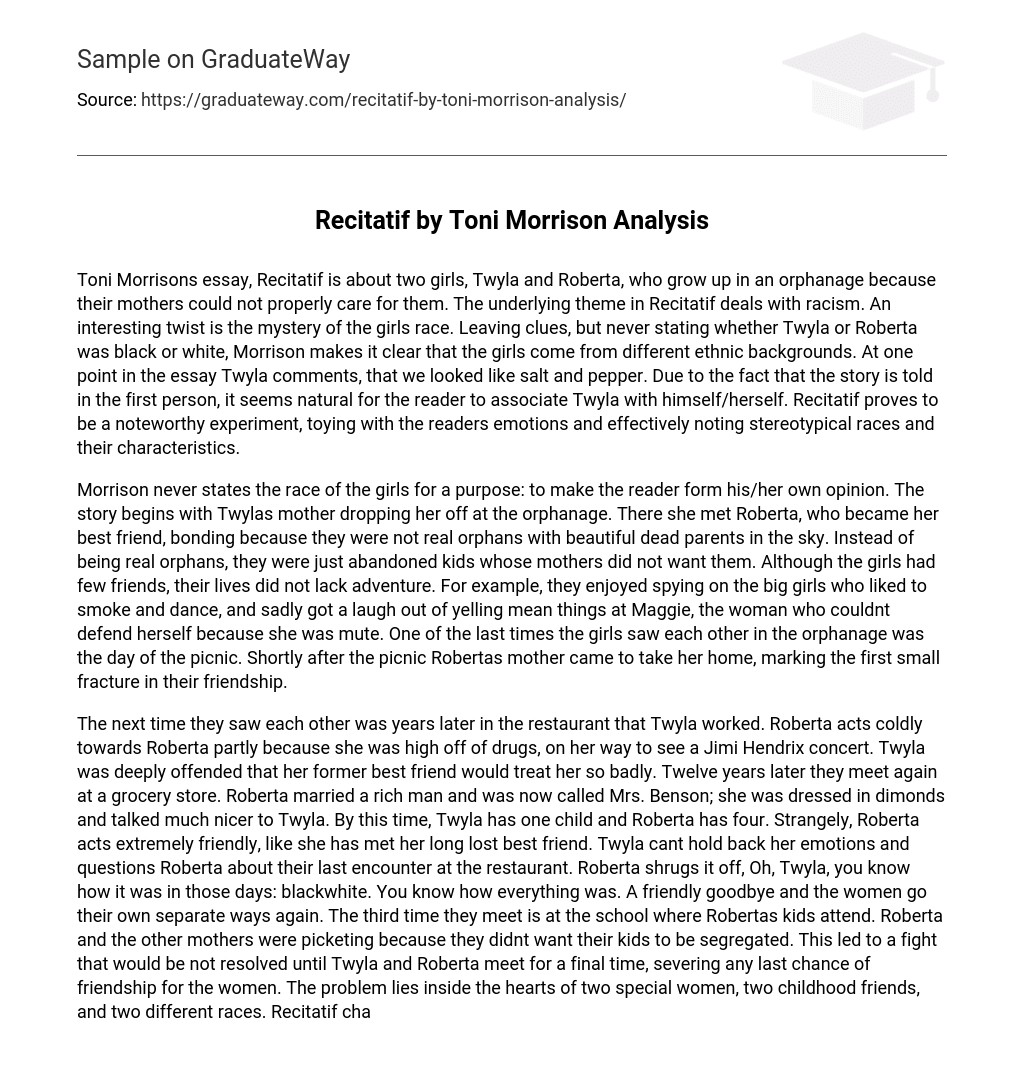Toni Morrison’s essay “Recitatif” centers around the upbringing of two girls, Twyla and Roberta, in an orphanage due to their mothers’ inability to care for them. The main focus of the essay is the presence of racism, with Morrison adding an intriguing twist by keeping the girls’ races ambiguous. Despite dropping hints, Morrison never explicitly reveals whether Twyla or Roberta is black or white, emphasizing that they come from different ethnic backgrounds. At one point, Twyla remarks that they resembled salt and pepper. As the story is told in first person, it is natural for readers to identify with Twyla’s perspective. “Recitatif” proves to be a significant experiment that plays with readers’ emotions and skillfully addresses common racial stereotypes.
Morrison intentionally leaves the race of the girls unspecified, allowing readers to draw their own conclusions. Twyla is left at an orphanage by her mother, where she meets Roberta and they quickly become best friends. Their bond is formed over being abandoned children rather than actual orphans with deceased parents in heaven. Despite having few acquaintances, they still manage to embark on adventures together, such as observing older girls who smoke and dance and teasing Maggie, a mute woman who lacks the ability to defend herself. The last time they encounter each other at the orphanage occurs during a picnic, after which Roberta’s mother comes to take her home, causing a slight strain in their friendship.
Years later, Twyla and Roberta coincidentally crossed paths at the restaurant where Twyla worked. Roberta, who was high on drugs on her way to a Jimi Hendrix concert, treated Twyla with indifference. This deeply hurt Twyla as she felt insulted by her former best friend’s behavior. After twelve years had passed, they unexpectedly bumped into each other again, this time at a grocery store. Roberta, now married to a wealthy man and known as Mrs. Benson, adorned herself with diamonds and spoke kindly towards Twyla. At this point in their lives, Twyla had one child while Roberta had four children of her own. Surprisingly enough, Roberta acted extremely friendly towards Twyla as if they were long-lost best friends reuniting after all these years. Overwhelmed by emotions, Twyla couldn’t contain herself and confronted Roberta about their unpleasant encounter at the restaurant in the past. However, Roberta brushed it off attributing their behavior to racial tensions during that time – “blackwhite,” she said.With a warm farewell exchanged between them both, the women once again went their separate ways.Their third meeting occurred at the school attended by Roberta’s children where she alongside other mothers picketed against segregation in schoolsThe text explores the unresolved conflict between two extraordinary women who were childhood friends but had different racial backgrounds. The story urges readers to avoid making assumptions based on race and instead accept the characters’ identities without judgment. Morrison subtly suggests the girls’ races, leading readers to speculate. The author introduces nameless girls without explicitly mentioning their races, yet includes elements related to black and white stereotypes. While the mystery remains unsolved, one’s interpretation is influenced by their own ethnicity.
Morrison embraces the stereotypes associated with both blacks and whites. For instance, Twyla’s mother once told her that “those people” had an unpleasant smell because they didn’t wash their hair regularly. This remark could imply that Roberta, who is possibly black, falls under this stereotype as black individuals are sometimes believed to have infrequent hair washing habits. Alternatively, Twyla’s mother may have been referring to the orphans’ lack of proper bathing, which could also result in an unpleasant odor. Thus, the situation remains ambiguous, residing within a gray area.
Twyla’s mother arrived at the picnic wearing tight green slacks that emphasized her posterior, causing Twyla to feel embarrassed. This could indicate that her mother was African American, as there is a stereotype suggesting that black individuals often have larger behinds. However, it is also possible that Twyla’s mother was simply a heavy Caucasian woman with a similar body type.
During the picnic, Roberta’s mother brought various food items, including chicken legs, ham sandwiches, oranges, and a box of chocolate-covered grahams. While Roberta’s mother read from the bible, Roberta drank milk from a thermos. Twyla noticed that the chicken legs were left uneaten and commented on how “the wrong food is always with the wrong people.” This remark implies that Twyla may have become a waitress in order to match suitable dishes with appropriate individuals.
There exists an unfair assumption that black people prefer chicken over white people do; this assumption could suggest that Twyla herself is black based on her distress over wasted chicken. However, it is important to acknowledge that not all black individuals enjoy eating chicken. Therefore, Twyla’s frustration may have originated from her personal craving for chicken at that specific moment.
Roberta displayed rude and distant behavior when she met Twyla at the restaurant where Twyla works. Roberta was accompanied by two other men and had a big, wild hairstyle that obscured her face. Despite this, Twyla still recognized her. The large and wild hairstyle resembled an Afro, which is often associated with black people. However, considering the time period of the story (the 1970s) when the Afro hairstyle was popular among different racial groups, it’s possible that anyone could have sported that hairstyle.
Furthermore, while at the restaurant, Roberta mentioned her plan to see Hendrix, referring to Jimi Hendrix, a famous black guitarist. This connection might lead readers to infer that Roberta is black. However, it’s worth noting that Jimi Hendrix’s band was racially diverse and had a wide-ranging audience. Therefore, Roberta’s association with Hendrix does not definitively determine her race; she could still be white because of the band’s diverse audience.
The story ends without revealing which girl is white or black, leaving readers uncertain about their races. This uncertainty highlights the significance placed on race in the narrative.
Bibliography:





